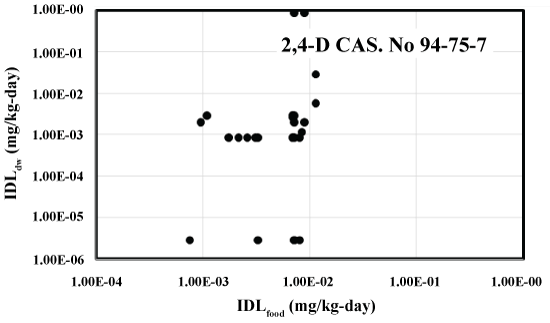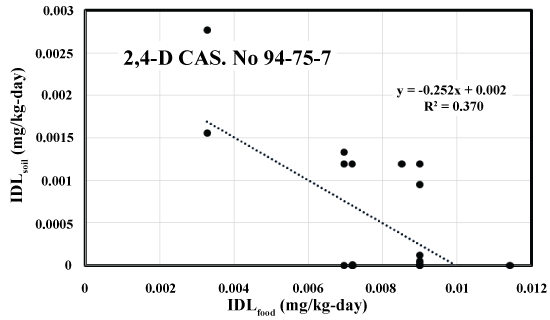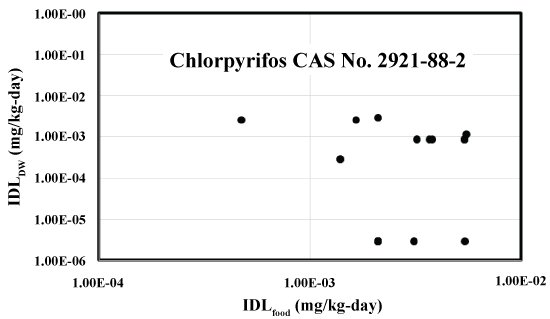Human could exposure to pesticides via various exposure pathways. Worldwide jurisdictions are making efforts to manage human health risk by regulating pesticide standards in residential soil, drinking water, and agricultural commodity. An assumption is made that if the pesticide standards were derived by human health risk model with essential toxic data, a relationship may exist between the standard values from different exposures. Implied Dose Limit (IDL) was introduced in this research to convert pesticide standards in different exposure pathways to pesticide exposure mass loading. Comparing all the IDLs of pesticides, it illustrates that pesticide standards in soil are probably more conservative than those in drinking water and food for most largely used pesticides worldwide. Result also shows that there is no significant relationship between any two IDLs computed from these exposure pathways, suggesting that worldwide jurisdictions derived the pesticide standards independently without considering the impacts of other major exposures.
Pesticide standard values, Implied dose limit, Human exposure, Exposure assessment, Largely used pesticides, POPs
Pesticide impact is a worldwide problem due to its toxicity and ecotoxicity potential and ubiquitous presence in the environment [1]. After applied, pesticides can be transported into surrounding environments such as soil, water, air, and living organisms. In addition, pesticides can get into human body by various exposure pathways [2] including ingestion, inhalation, and dermal contact [3]. Some Persistent Organic Pollutants (POPs) such as DDT can accumulate in human body over entire lifetime. Therefore, worldwide regulatory jurisdictions are making efforts to manage human health risk against pesticides by regulating Pesticide Standard Values (PSVs) in all possible exposure pathways. Developing PSVs regulations is a systematic and comprehensive work by considering all major exposures and applying the human health risk model. Previous studies [4-6] show that worldwide pesticide soil Regulatory Guidance Values (RGVs) are not harmonized, which could vary in five, six, or even seven orders of magnitude. Some RGVs seem too large to prevent human health impact and others are too small to achieve the remediation goal technically. A similar result was found for worldwide pesticide drinking water Maximum Concentration Levels (MCLs) [7]. In Li’s [7] study of pesticide agricultural commodity Maximum Residue Limits (MRLs) analysis, it shows that the MRLs do not vary as large orders of magnitude as soil RGVs and drinking water MCLs, but some extreme values are still not conservative enough to protect human health. Joon Chuah C, et al. [8], Rachel Baum, et al. [9], Winter and Jara [10], and Chen, et al. [11] have studied the PSVs in one of major exposure pathways as well. These studies have discussed and compared PSVs at different nations in a single exposure pathway. Li [7] introduced Implied Maximum Dose Limits (IMDLs) computed from all major exposures to analyze PSVs in a more comprehensive approach. The analysis of IMDLs may help worldwide jurisdictions on the study of PSVs because human exposures to pesticide always have various pathways. In this research, the relationship between PSVs was investigated among different exposure pathways. Moreover, this research has examined whether a nation regulated PSVs for major exposure pathways systematically by comparing the PSVs among different exposures.
The materials for this research are PSVs from worldwide jurisdictions in residential soil, drinking water, air, and agricultural commodity. Those PSVs were obtained from online data base with full references and web addresses listed in the Supplementary Material. When internet addresses and online documents become invalid and out of date, key words from the jurisdictions tittles would be used to address the new web location. At least 54 (28% of the worldwide nations) nations have regulated pesticide soil RGVs, 102 (52%) nations have provided drinking water MCLs, 90 (46%) nations had pesticide agricultural commodity MRLs, and only U.S. systematically provided pesticide air MCLs. Each pesticide was identified by a Chemical Abstracts Service Registry Number (CAS No.) instead of chemical nomenclature conventions, common names, and trade names because of the complex chemical structure.
A total of 14 current largely used pesticides and 11 largely used pesticides in the past were selected for analysis. The current largely used pesticides are 2,4-D, Aldicarb, Atrazine, Chlorothalonil, Chlorpyrifos, Diazinon, Dicamba, Diuron, Glyphosate, Malathion, Mancozeb, MCPA, Metolachlor, and Trifluralin. The historical largely used pesticides which have been banned in most countries are Aldrin, Bromomethane, Chlordane, DDT, Dieldrin, Endosulfan, Endrin, Heptachlor, Lindane, Pentachlorophenol, and Toxaphene. Also those 11 historical largely used pesticides are the Stockholm Convention POPs.
Since PSVs in different exposure pathways have different units (e.g. mg/kg for soil RGV, and mg/l for drinking water), IDL (mg/kg-day) was introduced to covert the PSVs in each exposure to the pesticide exposure mass loading, which assessed the total human mass burden implied by drinking water, soil, and agricultural food PSVs of regulatory jurisdictions. A relationship of the PSVs from different exposure pathways was expected if PSVs from different nations were developed in each exposure systematically and all based on human health risk model. Because few jurisdictions regulated PSVs in air, only IDLs computed from soil, drinking water, and agricultural commodity PSVs were conducted and expressed as follows.
For drinking water:
For residential soil:
For agricultural commodities:
All IDLs are based on the following set of exposure scenario coefficient values.
EF - Exposure Factor (1, unit less) [12]
HW - Human Weight (70 kg) [12]
V - Volume of water intake rate (2 L/day) [12]
CF - Convert Factor (106 mg/kg)
IR - Intake Rate for soil (mg/kg-day) [13]
ABSd - Absorption Factor (unit less) [13]
GIABS - GastroIntestinal Absorption Factor (unit less) [13]
IRi - Intake Rate for food i (kg/day)
The CDF analysis was used to plot the IDLs computed from soil, drinking water, and agricultural commodity exposures (Equation 4) and compared with the cumulative distribution of a lognormal random variable with identical statistics. Pearson correlation coefficients (r) between the empirical cumulative distribution and a theoretical normal or log-normal cumulative distribution with identical statistics were computed for PSVs in major exposures (Equation 5).
IDLr - a random IDL
IDLi - a known IDL
ni - integer rank of IDL in N known values
E (IDLi) - probability computed from IDL empirical cumulative distribution
F (IDLi) - probability computed from IDL theoretical normal or log-normal cumulative distribution
For those 14 current largely used pesticides and 11 Stockholm Convention POPs, IDLs computed from major exposures were illustrated as CDF and relationships between IDLs in two major exposures were explored. 2,4-D, Chlorpyrifos, and Lindane IDLs analyses were conducted in this study.
A total of 147, 180, and 91 computed 2,4-D IDLs from 2,4-D soil, drinking water, and agricultural commodity PSVs were illustrated as CDF in Figure 1 respectively. Both the IDLs computed from 2,4-D soil and water ranged in a span of 5.48 orders of magnitude. However, the IDLs computed from commonly consumed agricultural commodities only has a span of 1.33 orders of magnitude. In addition, the Pearson correlation coefficients for these IDLs listed in Table 1 suggest that 2,4-D soil and water IDLs are better dispersed over the data spans. The median and geometric means of these IDLs suggests that worldwide 2,4-D soil RGV and drinking water MCL sets are probably more conservative than MRL set.
 Figure 1: Worldwide computed 2,4-D IDLs from residential soil RGVs, drinking water MCLs, and commonly consumed agricultural commodities MRLs plotted in the form of CDF. View Figure 1
Figure 1: Worldwide computed 2,4-D IDLs from residential soil RGVs, drinking water MCLs, and commonly consumed agricultural commodities MRLs plotted in the form of CDF. View Figure 1
Table 1: Statistic summary of 2,4-D IDLs. View Table 1
A total of 20 national jurisdictions from the same nation regulated both 2,4-D soil RGVs and drinking water MCLs. Figure 2 illustrates that there is no significant relationship between computed 2,4-D IDLs from soil and water. Similarly, Figure 3 illustrates that there is no significant relationship between 20 computed 2,4-D ILDs from drinking water MCLs and commonly consumed agricultural commodities MRLs.
 Figure 2: Relationship between computed 2,4-D IDLs from residential soil RGVs and drinking water MCLs. View Figure 2
Figure 2: Relationship between computed 2,4-D IDLs from residential soil RGVs and drinking water MCLs. View Figure 2
 Figure 3: Relationship between computed 2,4-D IDLs from drinking water MCLs and commonly consumed agricultural commodities MRLs. View Figure 3
Figure 3: Relationship between computed 2,4-D IDLs from drinking water MCLs and commonly consumed agricultural commodities MRLs. View Figure 3
A total of 65 national jurisdictions (some jurisdictions share same PSVs) from the same nation regulated both 2,4-D soil RGVs and agricultural commodity MRLs. Figure 4 illustrates that there might be a linear relationship between the IDLs. 2,4-D soil IDL decreases when agricultural commodity increases. Some nations such as Peru, United Kingdom, and Philippines had very high IDLs (0.0072 mg/kg-day) computed from food jurisdictions but relatively low IDLs computed from soil jurisdictions (i.e. 1.73E-07 mg/kg-day for Peru, 8.65E-08 mg/kg-day for United Kingdom, and 1.73E-08 mg/kg-day for Philippines). On the other hand, the soil IDLs computed from the nations such as Chile and Ecuador were high but the food IDLs were low.
 Figure 4: Relationship between computed 2,4-D IDLs from soil RGVs and commonly consumed agricultural commodities MRLs. View Figure 4
Figure 4: Relationship between computed 2,4-D IDLs from soil RGVs and commonly consumed agricultural commodities MRLs. View Figure 4
A total of 102, 90, and 91 computed Chlorpyrifos IDLs from Chlorpyrifos soil, drinking water, and agricultural commodity PSVs respectively were illustrated as CDFs in Figure 5. The IDLs computed from Chlorpyrifos soil RGVs span 4.74 orders of magnitude and the drinking water IDLs span 3 orders of magnitude. However, the IDLs computed from commonly consumed agricultural commodities only span 1.42 orders of magnitude. Pearson correlation coefficients for these IDLs listed in Table 2 suggest all of the Chlorpyrifos IDLs are well dispersed over the data spans. The median and geometric means of these IDLs suggest that worldwide Chlorpyrifos soil RGV and drinking water MCL sets are probably more conservative than MRL set.
 Figure 5: Worldwide computed Chlorpyrifos IDLs from residential soil RGVs, drinking water MCLs, and commonly consumed agricultural commodities MRLs plotted in the form of CDF. View Figure 5
Figure 5: Worldwide computed Chlorpyrifos IDLs from residential soil RGVs, drinking water MCLs, and commonly consumed agricultural commodities MRLs plotted in the form of CDF. View Figure 5
Table 2: Statistic summary of Chlorpyrifos IDLs. View Table 2
A total of eight national jurisdictions from the same nation regulated both Chlorpyrifos soil RGVs and drinking water MCLs. Figure 6 illustrates that there is no significant relationship between computed Chlorpyrifos IDLs from soil and water. Figure 7 illustrates that there is no significant relationship between 42 computed Chlorpyrifos IDLs (some jurisdictions share same PSVs) from drinking water MCLs and commonly consumed agricultural commodities MRLs. Moreover, there is no a significant relationship between the Chlorpyrifos IDLs computed from soil RGVs and agricultural commodity MRLs (Figure 8).
 Figure 6: Relationship between computed Chlorpyrifos IDLs from drinking water MCLs and soil RGVs.. View Figure 6
Figure 6: Relationship between computed Chlorpyrifos IDLs from drinking water MCLs and soil RGVs.. View Figure 6
 Figure 7: Relationship between computed Chlorpyrifos IDLs from drinking water MCLs and commonly consumed agricultural commodities MRLs. View Figure 7
Figure 7: Relationship between computed Chlorpyrifos IDLs from drinking water MCLs and commonly consumed agricultural commodities MRLs. View Figure 7
 Figure 8: Relationship between computed Chlorpyrifos IDLs from soil RGVs and commonly consumed agricultural commodities MRLs. View Figure 8
Figure 8: Relationship between computed Chlorpyrifos IDLs from soil RGVs and commonly consumed agricultural commodities MRLs. View Figure 8
The Lindane IDLs were computed in soil and drinking water and there is no Lindane MRL regulated in agricultural commodity. A total of 190 and 66 computed Lindane IDLs from Lindane soil and drinking water PSVs respectively were illustrated as CDFs in Figure 9. The IDLs computed from Lindane soil RGVs span 7.81 orders of magnitude and the drinking water IDLs span 5.02 orders of magnitude. Pearson correlation coefficients for these IDLs listed in Table 3 suggest all of the Lindane IDLs are well dispersed over the data spans. The median and geometric means of these IDLs suggest that worldwide Lindane soil RGV set is probably more conservative than drinking water MCL set.
 Figure 9: Worldwide computed Lindane IDLs from residential soil RGVs and drinking water MCLs plotted in the form of CDF. View Figure 9
Figure 9: Worldwide computed Lindane IDLs from residential soil RGVs and drinking water MCLs plotted in the form of CDF. View Figure 9
Table 3: Statistic summary of Lindane IDLs. View Table 3
A total of eight national jurisdictions from the same nation regulated both Lindane soil RGVs and drinking water MCLs. Figure 10 illustrates that there is no a significant relationship between computed Lindane IDLs from soil and water.
 Figure 10: Relationship between computed Lindane IDLs from drinking water MCLs and soil RGVs. View Figure 10
Figure 10: Relationship between computed Lindane IDLs from drinking water MCLs and soil RGVs. View Figure 10
Table 4 provided the statistical summary of the IDLs computed from current largely used pesticides (Dicamba was omitted since few nations regulated PSVs for Dicamba in soil and drinking water). The means of the numbers of these pesticides IDLs computed from soil, drinking water, and food jurisdictions are 94, 95, and 85 respectively. In some nations, there is more than one jurisdiction to regulated soil and water standards, for example, in U.S., each state, city, and county could develop its own PSVs. For agricultural commodity, each nation has only one jurisdiction probably because of international trade need. There are 106 soil 2,4-D RGVs from U.S.-related jurisdictions and 41 from elsewhere from the world. A total of 56 drinking water Glyphosate MCLs are from U.S.-related jurisdictions and 66 MCLs are from international jurisdictions. However, only single 2,4-D and Glyphosate MRL was found in each agricultural commodity. The weighted average Pearson correlation coefficients for these current largely used pesticides soil RGVs and drinking water MCLs is 0.918 and 0.898, respectively, which are higher than agricultural commodity MRLs (0.838). A total of 12 these pesticides’ soil RGVs correlation coefficients are above 0.9. The correlation coefficient of Mancozeb soil RGVs is 0.589 because there are only 54 soil RGVs and the distribution is heavily skewed by the large data cluster. In addition, the orders of variance for IDLs computed from these major exposures indicate that worldwide jurisdictions probably agree more on agricultural commodity MRLs than soil RGVs and drinking water MCLs.
Table 4: IDLs statistics summary for current largely used pesticides. View Table 4
Previous studies show that median and geometric mean are better measures of PSVs central tendency [4-6]. The weighted average medians for soil and drinking water IDLs are 1.09 E-03 and 2.21 E-03 mg/kg-day respectively, and that for food IDLs is 1.17 E-02 mg/kg-day. Weighted average geometric means for soil and drinking water IDLs are 2.93 E-04 and 2.31 E-04 mg/kg-day respectively and that for agricultural commodity is 9.89 E-03 mg/kg-day. These results indicate that worldwide soil RGVs and drinking water MCLs are more conservative than agricultural MRL for current largely used pesticides. For most pesticides discussed in this study, there is no relationship among the IDLs computed from any two of these major exposures, which indicates that most worldwide jurisdictions develop their PSVs independently in soil, water, and food without considering other exposure pathways.
Table 5 provided the statistical summary of the IDLs computed from historical largely used pesticides (Bromomethane and Toxaphene were omitted because of few nations regulating soil RGVs and drinking water MCLs for these two pesticide). Since there is no jurisdiction providing agricultural commodity MRLs for these pesticides, only the information of the IDLs computed from soil RGVs and drinking water MCLs was summarized. The mean of the number of soil RGVs for these pesticides is 226 and that for drinking water MCLs is 127. DDT is the most regulated pesticide among the pesticides with 318 worldwide soil RGVs and Lindane is the most regulated pesticide in drinking water with 166 MCLs. Endosulfan were only regulated by 52 worldwide drinking water MCLs, and the U.S.-related jurisdictions did not provide the drinking water MCL for Endosulfan. Worldwide nations did not regulate pesticide agricultural commodity for these historical largely used pesticides because they had been banned in most countries and territories. However, since these POPs are environmentally persistent, it is necessary to regulate them for food to protect human health. The weighted average of Pearson correlation coefficients for these pesticides soil RGVs is 0.977 and for drinking water MCLs is 0.913. These pesticides soil RGVs weighted average of orders of variance is 7.07 while for drinking water MCLs it is 4.86. It suggests that worldwide soil RGVs are probably better dispersed over data spans for these historical largely used pesticides. The weighted averages of median (8.40 E-05 mg/kg-day) and geometric mean (6.79 E-06 mg/kg-day) for IDLs computed from these pesticides soil RGVs are less than those values in drinking water, which are 1.36 E-04 mg/kg-day for median and 1.77 E-05 mg/kg-day for geometric mean. This suggests that worldwide jurisdictions regulated soil RGVs more conservatively than drinking water MCLs in historical largely used pesticides. In addition, no relationship was found between IDLs computed from soil RGVs and drinking water MCLs for these historical largely used pesticides. Regulation of PSVs in each exposures is a systematical work, and hopefully the results in this research will help worldwide regulatory jurisdictions make their PSVs in a more comprehensive approach by considering all major exposures.
Table 5: IDLs statistics summary for historical largely used pesticides. View Table 5
The authors would like to appreciate the contributions from other scholars who provided help and suggestion to this research: Dr. Xiong (Bill) Yu and Dr. JennýBrynjarsdóttir.